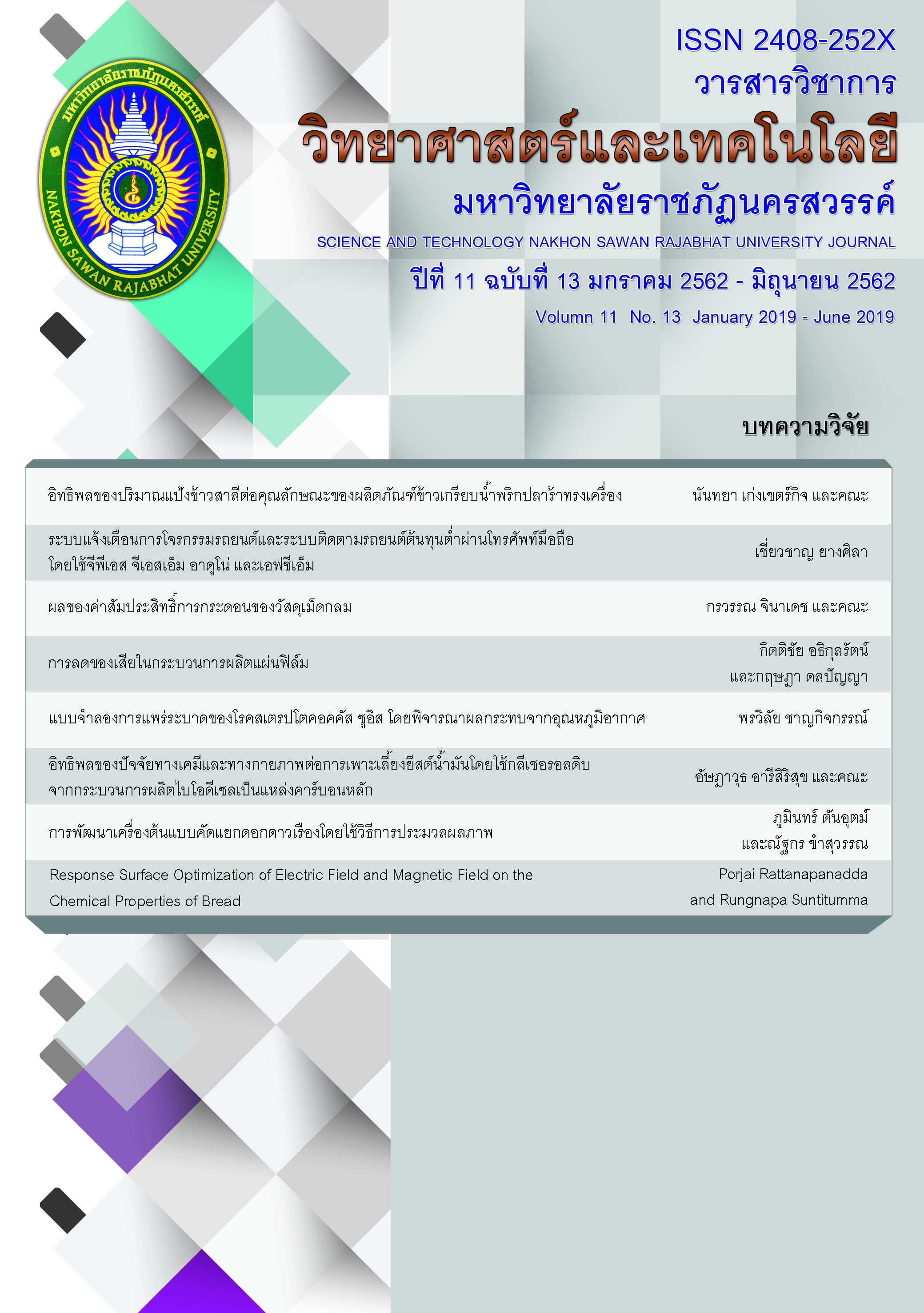อิทธิพลของปัจจัยทางเคมีและทางกายภาพต่อการเพาะเลี้ยงยีสต์น้ำมันโดยใช้กลีเซอรอลดิบจากกระบวนการผลิตไบโอดีเซลเป็นแหล่งคาร์บอนหลัก
Main Article Content
บทคัดย่อ
งานวิจัยนี้มีวัตถุประสงค์เพื่อศึกษาอิทธิพลของปัจจัยทางเคมีและปัจจัยทางกายภาพต่อการเพาะเลี้ยงยีสต์ที่มีคุณสมบัติสะสมน้ำมัน Pseudozyma parantarctica CHC28 โดยใช้กลีเซอรอลดิบซึ่งเป็นผลพลอยได้ของกระบวนการผลิตน้ำมันไบโอดีเซล (Biodiesel-Derived Crude Glycerol, BCG) เป็นแหล่งคาร์บอน ซึ่งทำการทดลองโดยแปรผันปัจจัยทั้งหมด 7 ปัจจัย (ความเข้มข้นกลีเซอรอล ปริมาณ (NH4)2SO4 ปริมาณ KH2PO4 ปริมาณ MgSO4 ปริมาณกล้าเชื้อ อัตราการเขย่าและอุณหภูมิ) ด้วยการวางแผนการทดลองแบบ Plackett-Burman Design (PBD) ผลการทดลองพบว่ายีสต์สามารถใช้ BCG ในการเจริญเติบโตและผลิตน้ำมันได้ทุกการทดลอง โดยมีการผลิตชีวมวลยีสต์ การผลิตน้ำมัน ปริมาณน้ำมันที่สะสมภายในเซลล์ และอัตราการผลิตน้ำมันสูงสุด เท่ากับ 4.68 กรัมต่อลิตร 2.53 กรัมต่อลิตร 54.06 เปอร์เซ็นต์โดยน้ำหนักชีวมวลแห้ง และ 0.84 กรัมต่อลิตรต่อวัน ตามลำดับ ผลการทดลองนี้แสดงให้เห็นว่าสามารถใช้ BCG ซึ่งเป็นแหล่งคาร์บอนที่มีราคาถูกในการเพาะเลี้ยงยีสต์ P. parantarctica CHC28 ได้ นอกจากนี้ยังพบว่าปัจจัยที่มีอิทธิพลสูงสุด 3 อันดับต่อการผลิตชีวมวลคือ ความเข้มข้นกลีเซอรอล ปริมาณ MgSO4 และอัตราการเขย่า โดยมีค่าการกระจายของอิทธิพล (Contribution Effect) เท่ากับ 49.46 22.18 และ 2.22 เปอร์เซ็นต์ ตามลำดับ ในขณะที่ความเข้มข้นของกลีเซอรอล ปริมาณ KH2PO4 และอัตราการเขย่า เป็นปัจจัยที่มีมีอิทธิพลสูงสุด 3 อันดับแรกต่อการผลิตน้ำมัน ซึ่งมีค่า Contribution Effect เท่ากับ 34.79 11.22 และ 10.73 เปอร์เซ็นต์ ตามลำดับ จากการทดลองยังพบว่าความเข้มข้นของกลีเซอรอล ปริมาณ MgSO4 และอัตราการเขย่า เป็นปัจจัยที่แสดงอิทธิพลในทางบวก (Positive Effect) ต่อชีวมวลและน้ำมัน ในขณะที่ปริมาณ KH2PO4 แสดงอิทธิผลในทางลบ (Negative Effect) ต่อการผลิตน้ำมัน งานวิจัยนี้จึงแสดงให้เห็นถึง BCG เป็นวัตถุดิบที่มีราคาถูกและน่าสนใจสำหรับใช้เป็นแหล่งคาร์บอนเพื่อการผลิตน้ำมันจากยีสต์
Article Details
References
Areesirisuk, A., Chiu, C., Liu, C., & Guo, J. (2015). A novel oleaginous yeast strain with high lipid productivity and its application to alternative biodiesel production. Applied Biochemistry and Microbiology, 51(4), 411–418.
Bligh, E. G., & Dyer, W. J. (1959). A rapid method of total lipid extraction and purification. Canadian Journal of Biochemistry and Physiology, 37(8), 911–917.
Bonturi, N., Crucello, A., Viana, A. J. C., & Miranda, E. A. (2017). Microbial oil production in sugarcane bagasse hemicellulosic hydrolysate without nutrient supplementation by a Rhodosporidium toruloides adapted strain. Process Biochemistry, 57, 16–25.
Chen, X.-F., Huang, C., Yang, X.-Y., Xiong, L., Chen, X.-D., & Ma, L.-L. (2013). Evaluating the effect of medium composition and fermentation condition on the microbial oil production by Trichosporon cutaneum on corncob acid hydrolysate. Bioresource Technology, 143, 18–24.
Cui, Y., Blackburn, J. W., & Liang, Y. (2012). Fermentation optimization for the production of lipid by Cryptococcus curvatus: Use of response surface methodology. Biomass and Bioenergy, 47, 410–417.
Dobrowolski, A., Mit
uła, P., Rymowicz, W., & Mirończuk, A. M. (2016). Efficient conversion of crude glycerol from various industrial wastes into single cell oil by yeast Yarrowia lipolytica. Bioresource Technology, 207, 237–243.
Duarte, S. H., Ghiselli, G., & Maugeri, F. (2013). Influence of culture conditions on lipid production by Candida sp. LEB-M3 using glycerol from biodiesel synthesis. Biocatalysis and Agricultural Biotechnology, 2(4), 339–343.
Ghorbel-Bellaaj, O., Hmidet, N., Jellouli, K., Younes, I., Maâlej, H., Hachicha, R., & Nasri, M. (2011). Shrimp waste fermentation with Pseudomonas aeruginosa A2: Optimization of chitin extraction conditions through Plackett–Burman and response surface methodology approaches. International Journal of Biological Macromolecules, 48(4), 596–602.
Gong, Z., Zhou, W., Shen, H., Zhao, Z. K., Yang, Z., Yan, J., & Zhao, M. (2016). Co-utilization of corn stover hydrolysates and biodiesel-derived glycerol by Cryptococcus curvatus for lipid production. Bioresource Technology, 219, 552–558.
Lin, L., Ying, D., Chaitep, S., & Vittayapadung, S. (2009). Biodiesel production from crude rice bran oil and properties as fuel. Applied Energy, 86(5), 681–688.
Manosak, R., Limpattayanate, S., & Hunsom, M. (2011). Sequential-refining of crude glycerol derived from waste used-oil methyl ester plant via a combined process of chemical and adsorption. Fuel Processing Technology, 92(1), 92–99.
Mathiazhakan, K., Ayed, D., & Tyagi, R. D. (2016). Kinetics of lipid production at lab scale fermenters by a new isolate of Yarrowia lipolytica SKY7. Bioresource Technology, 221, 234–240.
Polburee, P., Yongmanitchai, W., Honda, K., Ohashi, T., Yoshida, T., Fujiyama, K., & Limtong, S. (2016). Lipid production from biodiesel-derived crude glycerol by Rhodosporidium fluviale DMKU-RK253 using temperature shift with high cell density. Biochemical Engineering Journal, 112, 208–218.
Ratledge, C., & Wynn, J. P. (2002). The biochemistry and molecular biology of lipid accumulation in oleaginous microorganisms. Advances in Applied Microbiology, 51, 1–51.
Rossi, M., Buzzini, P., Cordisco, L., Amaretti, A., Sala, M., Raimondi, S., Matteuzzi, D. (2009). Growth, lipid accumulation, and fatty acid composition in obligate psychrophilic, facultative psychrophilic, and mesophilic yeasts. FEMS Microbiology Ecology, 69(3), 363–372.
Rymowicz, W., Fatykhova, A. R., Kamzolova, S. V., Rywińska, A., & Morgunov, I. G. (2010). Citric acid production from glycerol-containing waste of biodiesel industry by Yarrowia lipolytica in batch, repeated batch, and cell recycle regimes. Applied Microbiology and Biotechnology, 87(3), 971–979.
Saran, S., Mathur, A., Dalal, J., & Saxena, R. K. (2017). Process optimization for cultivation and oil accumulation in an oleaginous yeast Rhodosporidium toruloides A29. Fuel, 188, 324–331.
Sitepu, I. R., Garay, L. A., Sestric, R., Levin, D., Block, D. E., German, J. B., & Boundy-Mills, K. L. (2014). Oleaginous yeasts for biodiesel: Current and future trends in biology and production. Biotechnology Advances, 32(7), 1336–1360.
Tai, M., & Stephanopoulos, G. (2013). Engineering the push and pull of lipid biosynthesis in oleaginous yeast Yarrowia lipolytica for biofuel production. Metabolic Engineering, 15, 1–9.
Towijit, U., Amponpiboon, C., Sriariyanun, M., & Kongruang, S. (2014). Optimization of lipid production by oleaginous yeast using response surface methodology. Suranaree Journal of Science and Technology, 21, 321–328.
Wu, S., Zhao, X., Shen, H., Wang, Q., & Zhao, Z. K. (2011). Microbial lipid production by Rhodosporidium toruloides under sulfate-limited conditions. Bioresource Technology, 102(2), 1803–1807.

